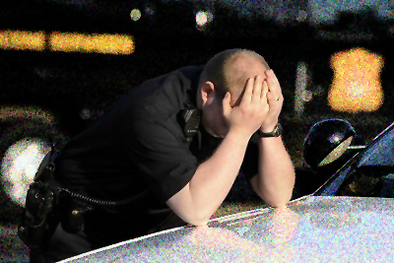 Is it possible for one man to punch another in the face without the capacity to understand the consequences? This was our theory and it made for a complicated legal battle.
Is it possible for one man to punch another in the face without the capacity to understand the consequences? This was our theory and it made for a complicated legal battle. Drivers swerve around a young man walking around in a busy tunnel. Shirtless and covered in soot, the young man is in obvious need of help. A passing officer puts his lights on and parks in the travel lane, protecting the man from oncoming traffic. The officer tries to move the young man to safety. The young man refuses.
Additional officers respond and after some cajoling, the young man briefly sits on the curb. Officer Sampson stands between the young man and passing vehicles. Suddenly, the young man jumps up and punches Officer Sampson in the mouth, splitting Officer Sampson’s upper lip. Knocked unconscious, Officer Sampson lands hard on the pavement. Officer Sampson awakes in a pool of his own blood. Nevertheless, Officer Sampson immediately joins the struggle to control the young man. Officer Sampson’s use of pepper spray ultimately forces the young man to relent.
Officer Sampson recovered from his physical injuries and returned to duty. He was later honored by his department. The young man was found not criminally responsible for his assault on Officer Sampson due to a lack of mental capacity.
It is clear PTSD affects first responders at a significant rate. Officer Sampson became increasingly fearful after learning a fellow officer and personal friend of his was violently injured in near identical circumstances nearly a year-to-the-day from his own attack. Officer Sampson showed classic signs of PTSD including recurrent nightmares and sudden mood changes like unexplained rage.
The ensuing legal battle was complicated and centered around the question of whether an individual who was not criminally responsible for his actions owed any duty to the officer he attacked and whether he could be held civilly responsible. In addition, the insurance company that insured the young man initially refused to pay the claim, arguing that the young man intentionally injured the officer.
Critical to this case was taking the young man’s father through a detailed deposition. The father testified that his son had gone off his medication three days prior to the attack. Arguing this case then became a delicate balance between showing two things: First, that the young man had sufficient understanding of his actions in negligently failing to take his medication; and second, that the young man negligently failed to use care in dealing with Officer Sampson, albeit without the capacity to understand the consequences of punching him. In the end, we were successful and recovered the maximum available insurance for Officer Sampson and his family, $300,000.
It is an honor and privilege to represent those who protect and serve, and we have worked with officers over the years who have suffered PTSD. If you or anyone you know may be dealing with such symptoms, please seek support. There are many resources available.
- Zachary M. Ballin, Esq.
In order to protect the privacy of the injured officer and witnesses, all names have been changed. Any resemblance to names of real persons, past or present, is merely coincidental and not intended. The injured officer agreed to have this article published in order that police officers around the Commonwealth be better educated about PTSD and their legal rights to compensation when injured.

 RSS Feed
RSS Feed
